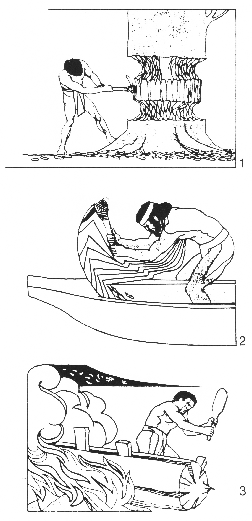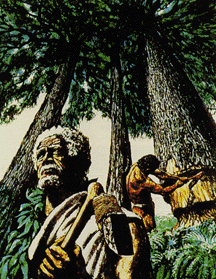Ships with Souls
Herb Kawainui Kāne
(From from Polynesian Seafaring Heritage, Honolulu: PVS and Kamehameha Schools, 1980, edited by Cecilia Kapua Lindo and Nancy Alpert Mower.)
A tree for a new canoe, by Herb Kane
The building of a canoe was a religious event, marked by prayers, ceremonies, and feasts. On the last night of the moon before construction began, Tahitian craftsmen "put their adzes to sleep" in a sacred place and implored Tāne, god of the land, to charge them with his power. Next morning, the men "awakened" their adzes by dipping them in the sea and work proceeded.
Since trees were the children of Tāne, the workers invoked the god's permission before felling them. Wielding a stone adz, prime tool of a people without metals, a woodsman made concave cuts around a tree trunk, then chopped away the wood between the cuts (1).
With songs and chants, the entire community turned out to haul the great logs to the canoe yard. There the adz fairly flew, as an artisan hewed a keel or carved a dugout (2). When blades grew brittle with heat, craftsmen cooled their adzes by plunging them into the moist trunks of banana trees, then sharpened them on blocks of sandstone.
Green logs were heated on a fire until they split (3). With wedges and maul, a workman chiseled off planks for a sailing canoe's hull and deck, then adzed them to shape.

Children brought strips of pandanus leaves to the women, who plaited them into sails with a texture almost as fine as cotton. Gossiping old men rolled coconut-husk fibers into string on their thighs, then braided it into a cord called sennit.
The builders lashed hull planks together with the sennit, again invoking the assistance of Tāne: "'This sennit of thine, O Tāne, make it hold, make it hold."
Bibliography: Traditional Canoe-Building
Buck, Peter (Te Rangi Hiroa). Vikings of the Pacific. Chicago: University of Chicago Press, 1959. (Originally published in 1938 by J.B. Lippincott Co.)
Dodd, Edward. Polynesian Seafaring. New York: Dodd Mead, 1972.
Fornander, Abraham. Fornander Collection of Hawaiian Antiquities and Folk-lore, Vol. 4, 5, and 6. Honolulu: Bishop Musuem, 1916-1919.
Haddon, Alfred, and James Hornell. Canoes of Oceania. Honolulu: Bishop Museum Press, 1936-1938.
Hiroa, Te Rangi (Peter Buck). Arts and Crafts of Hawaii, Section VI Canoes. Honolulu: Bishop Museum Press, 1964.)
Holmes, Tommy. The Hawaiian Canoe. Honolulu: Editions Limited, 1981.
'I'i, John Papa. "Canoes" in Nupepa Kuokoa, March 26, 1870.
Kalokuokamaile, Z.P. K. "Canoe Making and Descriptions" in Nupepa Kuokoa, October 26, 1922-February 15, 1923. A translation by Mary Kawena Pukui is available in the Bishop Museum Archives.
Kamakau, Samuel M. Works of the People of Old. Honolulu: Bishop Museum Press, 1976, 118-122.
Kane, Herb Kawainui. Voyagers. Bellevue, WA: Whalesong, 1991.
Lindo, Cecilia Kapua and Nancy Alpert Mower, ed. Polynesian Seafaring Heritage. Honolulu: Kamehameha Schools, 1980.
Malo, David. Hawaiian Antiquities. Honolulu: Bishop Museum Press, 1951, 126-132.

